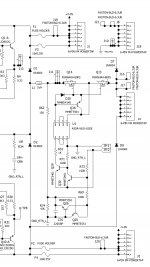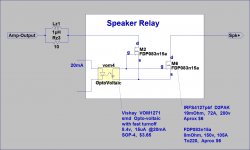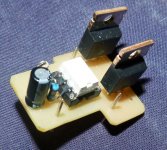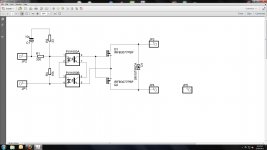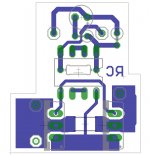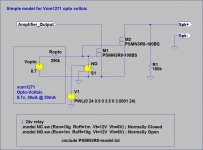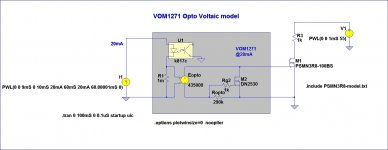A PNP emitter follower probably works better than a resistor would in quickly discharging the gates of the MOSFETs. It might be non-desirable that R7 can bleed off the precious pv voltage. I have a MOFET relay built into my latest amp project. I got the MOSFET and the pv driver from avnet. I bench-tested the relay and it worked very well. The circuit is posted below if it helps. Q36 is the emitter follower:
Attachments
Hi,
Just in case you want to try it attached it is schematic of my solid state relay using an avago Dual Channel Photovoltaic MOSFET Driver. I have been using it in my LM3886 amplifier for about one year with no problems. You can see the scope open/close time signal in my thread Protecting the speaker output using a microprocessor
Just in case you want to try it attached it is schematic of my solid state relay using an avago Dual Channel Photovoltaic MOSFET Driver. I have been using it in my LM3886 amplifier for about one year with no problems. You can see the scope open/close time signal in my thread Protecting the speaker output using a microprocessor
Attachments
Substituting a 2N5401/1N4148 per nattawa's diagram gave a longer turn-off time than the resistor in LTSpice. I got 65uS.
Using tauro0221's circuit, which looks a lot like one on Rod Elliott's site, required that I add another HCNR200 to the stack before it started to work. But once it did work in LTSpice, I got about a 5uS turn-off time. Not bad.
I'm not sure I understand these results. Maybe it has something to do with base/gate capacitance of the added PNP/NJFET.
Using tauro0221's circuit, which looks a lot like one on Rod Elliott's site, required that I add another HCNR200 to the stack before it started to work. But once it did work in LTSpice, I got about a 5uS turn-off time. Not bad.
I'm not sure I understand these results. Maybe it has something to do with base/gate capacitance of the added PNP/NJFET.
The relatively new Vishay VOM1271 opto-photovoltaic device seems to be the best device to use for driving a pair of mosfet relay switches. It includes a fast turn off circuit. The opto LED needs to be driven between 10mA and 20mA for best results.
See attachment for the mosfet relay concept, and the vom1271 datasheet at http://www.vishay.com/docs/83469/vom1271t.pdf
Note that I haven't tried this circuit yet, though I have bought the bits.
Paul Bysouth
See attachment for the mosfet relay concept, and the vom1271 datasheet at http://www.vishay.com/docs/83469/vom1271t.pdf
Note that I haven't tried this circuit yet, though I have bought the bits.
Paul Bysouth
Attachments
Paul, those switching times shown in the VOM1271 datasheet look good. But do I understand the waveform for the switching time test correctly? It appears that the output is inverted relative to the input. Is it an inverting device?
Vishay does not provide a Spice model that I can find. Too bad.
Vishay does not provide a Spice model that I can find. Too bad.
That Vishay driver looks very good. Using a standard photo coupler, you can get turn off times down to about 100 to 200 us (2 in parallel). The integrated turn off circuit is neat, and means you can create a really fast solid state loudspeaker relay.
I am Quite happy with the "old fashioned" PVI1050A .
Working great as a Songle 30A relay drop-in I made a while ago for my 5 channel HT amp with 5 LJM's L15D's .
very low RDsOn fast switch on an off , can't find scope pictures at the moment , but will keep looking .
Cheers ,
Rens
I know , some pins of the PV are not seated , but my rottie pinched my glasses from the bench before I took the picture of the PCB
Working great as a Songle 30A relay drop-in I made a while ago for my 5 channel HT amp with 5 LJM's L15D's .
very low RDsOn fast switch on an off , can't find scope pictures at the moment , but will keep looking .
Cheers ,
Rens
I know , some pins of the PV are not seated , but my rottie pinched my glasses from the bench before I took the picture of the PCB
Attachments
Last edited:
post87,
no resistor from gate to source?
My compliments on reading the schematics AndrewT
Cheers ,
Rens
Thank you to everyone who posted ideas and schematics. I have located some VOM1271 that I can import into my country without excessive expense. I'll give the VOM1271 a go.
The relatively new Vishay VOM1271 opto-photovoltaic device seems to be the best device to use for driving a pair of mosfet relay switches. It includes a fast turn off circuit. The opto LED needs to be driven between 10mA and 20mA for best results.
See attachment for the mosfet relay concept, and the vom1271 datasheet at http://www.vishay.com/docs/83469/vom1271t.pdf
Note that I haven't tried this circuit yet, though I have bought the bits.
Paul Bysouth
Hi Paul ,
Just interested if your relay works 🙂
Cheers ,
Rens
Rens,
No I haven't built the mosfet relay yet! I've spent most of the year working on a 1000 watt class D subwoofer, so no time for my projects.
If anybody wants to use LTspice to simulate the vom1271 optovoltaic, I use either of the two following `simple' models below.
Some time ago (3 years ago I think), I built a number of prototype 250 watt power amps that used `mosfet relays' in the power rails. These used large FQA32n20c mosfets driven by a rather complex opto coupler based drive circuit, and where situated after the power supply Capacitors and fuse, and before 2*47uF caps on the power amp. If either fuse opened, then both `relays' opened and disconnected both power rails. Experiments with pulling a fuse out while the amp was working (a bit scary when you have +-70v rails) did not produce any audible thumps - the test signal just stopped!
Regards,
Paul Bysouth
No I haven't built the mosfet relay yet! I've spent most of the year working on a 1000 watt class D subwoofer, so no time for my projects.
If anybody wants to use LTspice to simulate the vom1271 optovoltaic, I use either of the two following `simple' models below.
Some time ago (3 years ago I think), I built a number of prototype 250 watt power amps that used `mosfet relays' in the power rails. These used large FQA32n20c mosfets driven by a rather complex opto coupler based drive circuit, and where situated after the power supply Capacitors and fuse, and before 2*47uF caps on the power amp. If either fuse opened, then both `relays' opened and disconnected both power rails. Experiments with pulling a fuse out while the amp was working (a bit scary when you have +-70v rails) did not produce any audible thumps - the test signal just stopped!
Regards,
Paul Bysouth
Attachments
To output this works well, tested, you could not also be used to switch input, if it was overshadowed by against interference?
I'm thinking to use MOSFET relay in my next PA amplifier. It's running +/-85V, and can drive 2ohms load as well.
My idea to use ASSR-V621 driver and IRFB4127 MOSFETs. My only question if the MOSFETs are strong enough (200V 76A) in case of DC failure...
Sajti
My idea to use ASSR-V621 driver and IRFB4127 MOSFETs. My only question if the MOSFETs are strong enough (200V 76A) in case of DC failure...
Sajti
You have fuse on the rail?
I have SS relay at the output of my OPS board. I use TK72A12N1 120V, 4.5mohm max. almost 5 times lower than the one you choose. I even parallel two SS relay to get the total resistance of 4.5mohm max.
I have SS relay at the output of my OPS board. I use TK72A12N1 120V, 4.5mohm max. almost 5 times lower than the one you choose. I even parallel two SS relay to get the total resistance of 4.5mohm max.
As I'm still working on the amplifier, there is no problem to put or not put fuses...
Your mosfets looks Nice, however 120V is not enough to me. And 4127 has quite low on resistance, with small package, and moderate price.
My second possibility to use triac crowbar instead of relay.
Sajti
Your mosfets looks Nice, however 120V is not enough to me. And 4127 has quite low on resistance, with small package, and moderate price.
My second possibility to use triac crowbar instead of relay.
Sajti
- Status
- Not open for further replies.
- Home
- Amplifiers
- Solid State
- MosFet Relays
